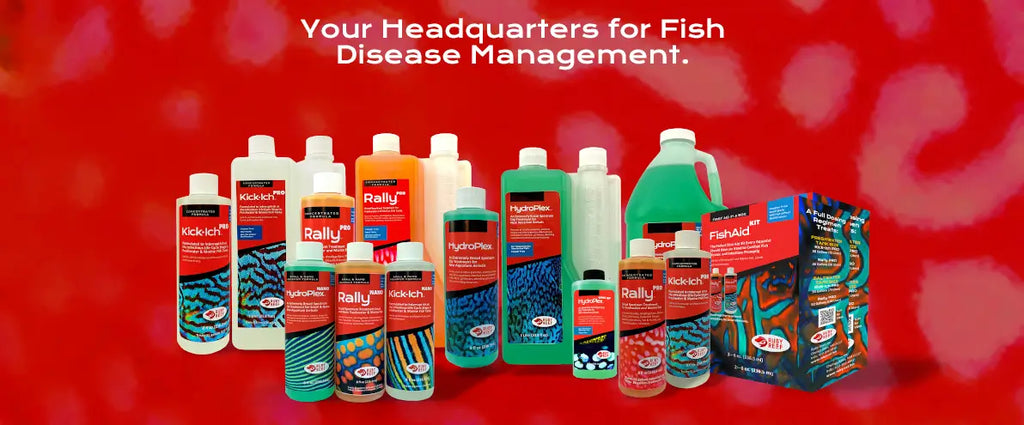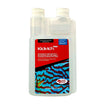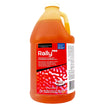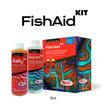- No products in the cart.
Saltwater Velvet Treatment: Effective Strategies for Combatting Aquarium Parasites
19
Sep
Saltwater velvet disease, also known as "marine velvet," is a severe parasitic infection that targets marine fish in both home aquariums and large-scale aquaculture operations. Caused by dinoflagellates, particularly those in the genus Amyloodinium, this disease can be lethal if not promptly and effectively treated. This blog explores the symptoms, diagnosis, and treatment options for managing saltwater velvet, ensuring your aquatic pets remain healthy and vibrant.
Identifying Saltwater Velvet Disease
Saltwater velvet is often mistaken for other diseases due to its common symptoms, which include listlessness, rubbing against objects, rapid gill movement, and a velvety, gold or rust-colored dusting on the skin. The disease progresses quickly and can lead to severe respiratory distress, as the parasites compromise the fish's gill function.
Early detection is crucial. The first step in managing an outbreak is a thorough observation of your fish's behavior and appearance. If you notice the characteristic dusty appearance or any change in behavior, it’s important to act fast.
Diagnosis of Saltwater Velvet
Accurate diagnosis often requires microscopic examination of skin scrapings. This examination can reveal the presence of the oval dinospores characteristic of the Amyloodinium parasite. Aquarium owners suspecting saltwater velvet should consult with a marine veterinarian or an experienced aquarist to confirm the diagnosis and discuss treatment options.
Treatment Options
Copper-Based Treatments: Copper sulfate is a traditional remedy for saltwater velvet. It’s effective because it disrupts the parasite's metabolism. However, using copper requires precision; the therapeutic range is narrow, and too much copper can be toxic to fish. It's critical to use a copper test kit to maintain appropriate levels throughout the treatment period.
Chloroquine Phosphate: This medication has gained popularity for its efficacy against a wide range of protozoan infections, including saltwater velvet. Chloroquine is typically less stressful on the aquarium’s biological filter than copper, but it must be used carefully to avoid adverse effects on certain fish species and invertebrates.
Formalin Treatments: Formalin effectively eliminates free-swimming stages of the parasite. It's used in baths, which are short-term exposures to the medication in a separate treatment tank. While effective, formalin can be harsh and should only be administered with proper ventilation and strict adherence to dosage guidelines.
Hydrogen Peroxide: Used in short baths, hydrogen peroxide can help reduce the parasite load on infected fish. This method is generally considered safe for use in reef tanks, as it breaks down quickly and doesn’t leave harmful residues.
Environmental Management
In addition to direct treatment, managing the aquarium environment is crucial:
Temperature Adjustment: Increasing the water temperature can speed up the life cycle of the parasite, reducing the duration of the outbreak. However, this should be done cautiously to avoid stressing the fish further.
UV Sterilizers and Ozone Generators: These devices can help control the spread of parasites by killing free-swimming stages in the water.
Water Quality: Maintaining pristine water conditions through regular changes and testing can significantly help support the immune system of your fish, making them less susceptible to diseases.
Prevention is Key
Preventative measures are essential to avoid the introduction and spread of saltwater velvet. Quarantining new arrivals for at least two to four weeks gives you time to observe the fish for any signs of disease before introducing them to your main tank. Additionally, enhancing biosecurity measures, such as disinfecting nets and equipment and managing stress levels in your aquarium, can prevent many issues associated with marine parasites.
Conclusion
Treating saltwater velvet is challenging but manageable with the right approach and quick action. Regular monitoring, effective treatment, and good aquarium practices can keep your marine life healthy and thriving. Remember, when dealing with any fish disease, especially one as aggressive as saltwater velvet, early detection and treatment are critical to success.






